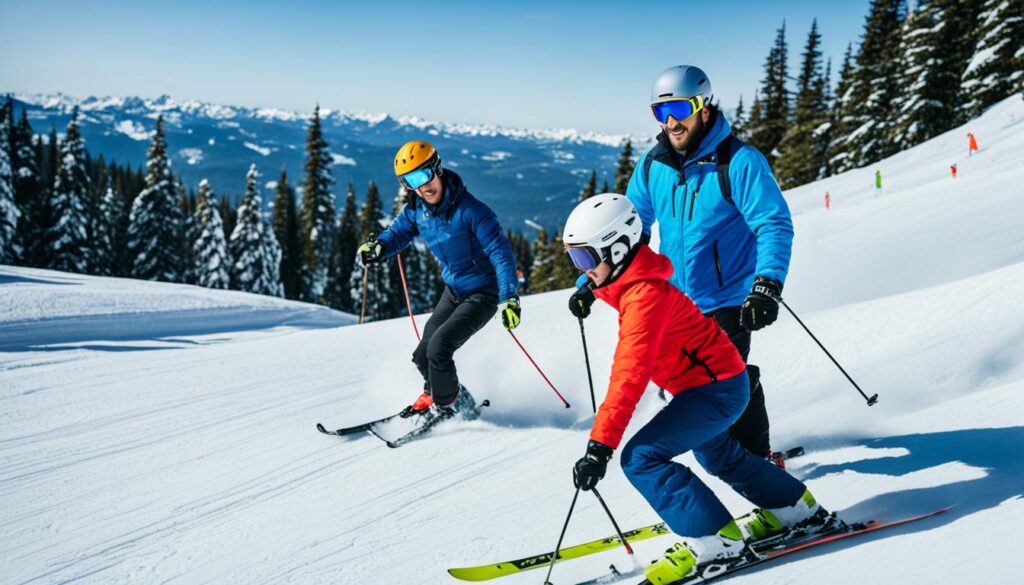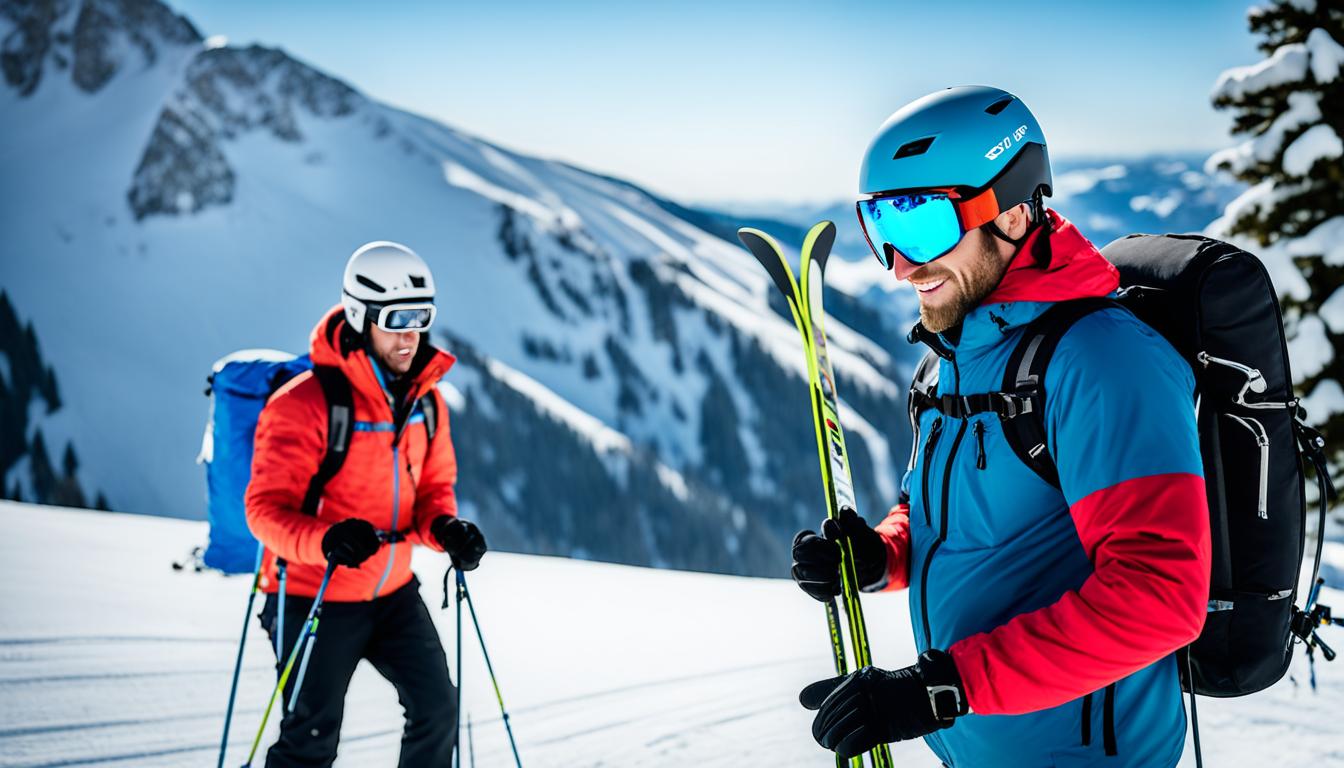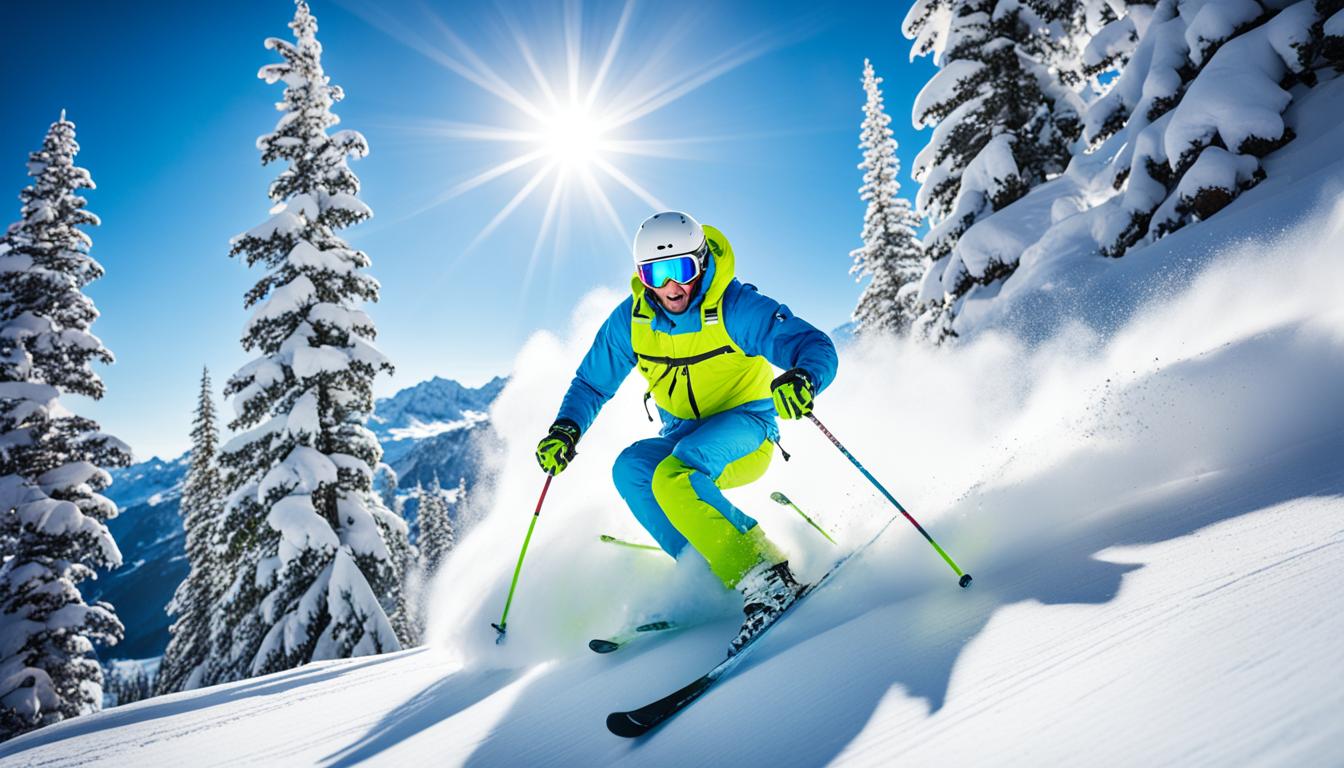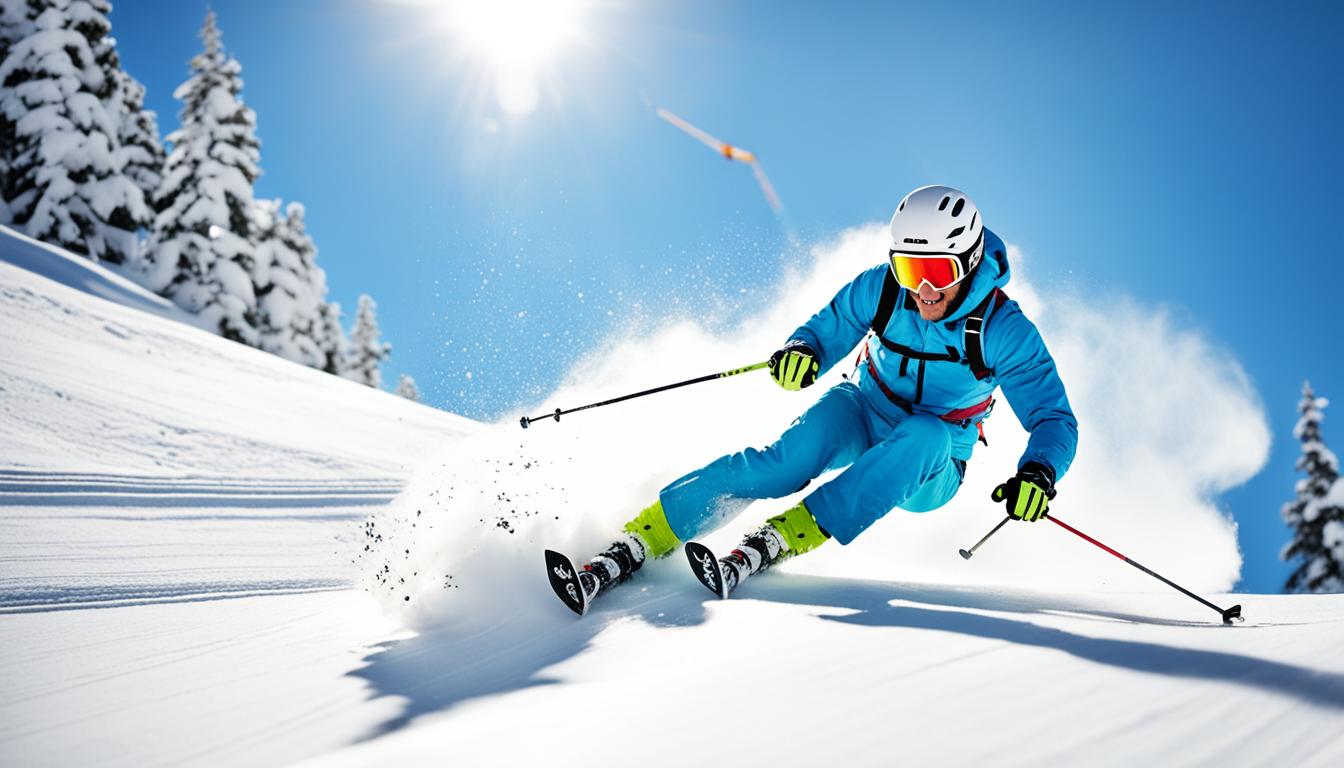When it comes to skiing, safety should always be a top priority, especially for beginners. By following these essential ski safety tips, you can ensure a fun and secure experience on the slopes.
These tips include checking your equipment, knowing the rules of the slopes, being aware of seasonal conditions, knowing what to do in case of an accident, and staying within your limits. Additionally, taking a lesson with a trained professional and being educated about backcountry skiing are important aspects of ski safety for beginners.
Key Takeaways:
- Check your equipment before hitting the slopes.
- Know and abide by the rules of the slopes, such as the Responsibility Code.
- Be aware of seasonal conditions and respect closures implemented by ski patrol.
- Know what to do in case of an accident, such as calling ski patrol for assistance.
- Stay within your skill and fitness levels and avoid skiing or riding too fast.
Check Your Equipment
Before hitting the slopes, it’s crucial to check your equipment to ensure everything is functioning properly. By following these ski safety guidelines and properly inspecting your gear, you can prevent potential accidents or malfunctions on the mountain.
Start by examining your skis or snowboard for any visible damage or signs of wear and tear. Look for cracks, delamination, or loose bindings. If you notice any issues, it’s best to have them repaired or replaced before heading out.
Next, it’s essential to have a local ski shop perform a function test on your bindings. This test checks if your bindings release correctly under the appropriate pressure, reducing the risk of knee or leg injuries. A professional technician can adjust the bindings to the appropriate setting based on your skill level, weight, and boot size.
By ensuring your equipment is in good condition and properly adjusted, you can confidently enjoy your time on the slopes while minimizing the chance of accidents. Remember, skis and snowboards are essential ski safety essentials, so investing some time in their maintenance is vital to your safety.
Know The Rules Of The Slopes
Understanding and following the rules of the slopes is essential for ski safety. By familiarizing yourself with the Responsibility Code, you can ensure a safe and enjoyable skiing experience. The Responsibility Code, which is printed on every trail map, outlines important rules that all skiers and snowboarders should adhere to:
- Always stay in control: Maintain a speed that allows you to stop or avoid other people or objects on the slopes.
- Yield to others: Skiers and snowboarders ahead of you have the right of way. It is your responsibility to avoid them.
- Use devices to prevent runaway equipment: Ensure your bindings are properly adjusted and functioning to prevent your equipment from sliding down the mountain uncontrollably.
- Observe posted signs and warnings: Pay attention to signs indicating the difficulty level of trails and take note of any warnings or closures.
By following these rules, you not only protect yourself but also contribute to a safe environment for all skiers and snowboarders on the mountain.

Why Follow the Rules?
“By understanding and adhering to the rules of the slopes, we create a harmonious and safe skiing environment. It allows us to avoid collisions and accidents, ensuring an enjoyable experience for everyone.” – National Ski Patrol
Beware Of Seasonal Conditions
When it comes to skiing, staying informed about seasonal conditions is crucial for ensuring your safety on the slopes. As a newbie skier, being aware of these conditions can help you make more informed decisions and navigate the mountain with confidence.
Early season skiing poses unique challenges, as there may be hidden obstacles and hazards that are not marked. Pay close attention to the terrain and maintain a cautious approach, especially in areas that might appear safe but could have hidden dangers.
Additionally, it’s important to watch out for large snowstorms or strong winds, as these weather conditions can increase the risk of avalanches. Always check the weather forecast and listen to updates from the ski resort or mountain staff. If there are any closures or warnings in place, it’s essential to respect them for your own safety.
Remember, your safety should always be a top priority when skiing. Being mindful of seasonal conditions can help you make informed decisions and reduce the risk of accidents.
Stay updated with the latest information and guidelines provided by the ski resort or mountain staff. By staying informed, you can better navigate the mountain and enjoy a safer skiing experience.
In the next section, we’ll take a closer look at what to do in case an accident happens on the slopes.
Seasonal Conditions and Ski Safety Tips
| Seasonal Condition | Ski Safety Tips |
|---|---|
| Early season skiing |
|
| Snowstorms and high winds |
|
Know What To Do When An Accident Happens
Accidents can happen on the slopes, so it’s crucial to know how to react and provide help when needed. If you come across an accident, cross your skis or place your snowboard above the injured person, make note of the injury type and location, and call ski patrol for assistance. It’s important not to let an injured person ski or ride down and to stay on the scene until patrol arrives. By knowing what to do in case of an accident, you can ensure the injured person receives proper care and minimize the risk of further harm.
| Ski Safety Tips | Precautions |
|---|---|
| Frequently review the Responsibility Code, which outlines important safety rules on the slopes. | Following the Responsibility Code helps maintain a safe skiing environment for everyone. |
| Never attempt to move an injured skier or snowboarder unless it is necessary to prevent further harm. | Moving an injured person incorrectly could worsen their injuries. |
| Stay with the injured person until ski patrol arrives, offering support and reassurance. | The injured person may require emotional or physical support until professional help arrives. |
| Be prepared to provide the exact location of the accident to ski patrol. | Knowing the location helps ski patrol respond quickly and efficiently. |
Remember, accidents can be stressful, but staying calm and following proper procedures can make a significant difference in ensuring the safety and well-being of those involved.
Know Your Limits
Understanding your limits is essential for ski safety, especially as a beginner. It’s important to ski and ride within your skill and fitness levels and avoid being persuaded by friends to go to places that may exceed your abilities. By staying within your comfort zone, you can maintain control and avoid accidents. Additionally, skiing or riding too fast can result in losing your pass, so it’s important to ski at a safe and controlled speed.
When it comes to skiing, each person has different abilities and comfort levels. It’s crucial to recognize and respect these limits to ensure a safe and enjoyable experience on the slopes. Pushing yourself too hard or attempting advanced terrains before you’re ready can increase the risk of injury. Remember, skiing is a sport that requires practice and skill development over time, so it’s essential to progress at your own pace.
One way to gauge your skiing limits is by evaluating your comfort level on different types of slopes. Start on easier terrain, such as green runs, and gradually work your way up to more challenging slopes as your skills improve. This progressive approach will build your confidence and help you become a better skier without compromising your safety.
It’s also important to listen to your body and take breaks when needed. Skiing can be physically demanding, and fatigue can affect your reaction time and decision-making abilities. Resting when you’re tired will help you ski more effectively and reduce the risk of accidents.
Remember, skiing should be a fun and enjoyable experience for all. By knowing your limits and skiing within them, you can have a safe and memorable time on the slopes.

Conclusion
As beginners, prioritizing safety is paramount when embarking on the thrilling adventure of skiing. By following these essential ski safety tips, you can ensure a fun and secure experience on the slopes. Remember, safety should always be the top priority.
First and foremost, check your equipment before hitting the slopes. Whether it’s your skis or snowboard, ensure everything is in good condition. Have a local shop perform a function test on your bindings to prevent any potential accidents or malfunctions.
In addition to equipment checks, familiarize yourself with the rules of the slopes. The Responsibility Code outlines crucial guidelines such as staying in control, yielding to others, and using devices to prevent runaway equipment. By knowing and abiding by these rules, you can keep yourself and others safe on the mountain.
Pay attention to seasonal conditions and respect closures implemented by ski patrol. Hidden obstacles during early season skiing or increased risk of avalanches due to large snowstorms can pose danger. Stay informed and adapt your skiing to ensure a safe experience.
Knowing how to react in case of an accident is crucial. If you come across an injured person, cross your skis or place your snowboard above them and call ski patrol for assistance. Stay on the scene until help arrives. Being prepared to handle accidents can help minimize the risk of further harm.
Lastly, understand your own limits. Ski within your skill and fitness levels, and avoid being persuaded by others to go beyond your abilities. Maintaining control and skiing at a safe and controlled speed are key to a safe skiing experience.
By taking these ski safety precautions, beginners can enjoy the slopes responsibly and ensure a fun-filled adventure while minimizing the risks. Remember, safety first!
FAQ
Why is it important to check your equipment before skiing?
Checking your equipment ensures that everything is functioning properly, reducing the risk of accidents or malfunctions on the mountain.
What are the rules of the slopes that beginners need to know?
The Responsibility Code provides important rules such as staying in control, yielding to others, and using devices to prevent runaway equipment. Following these rules keeps everyone safe on the mountain.
How do seasonal conditions affect skiing safety?
Seasonal conditions such as hidden obstacles, avalanches, and closures implemented by ski patrol can impact safety. Paying attention to these conditions reduces the risk of accidents.
What should I do if I come across an accident on the slopes?
If you encounter an accident, cross your skis or place your snowboard above the injured person, call ski patrol for assistance, and stay on the scene until help arrives. This ensures the injured person receives proper care.
Why is it important to know your limits as a beginner skier?
Understanding and staying within your skill and fitness levels helps maintain control and prevents accidents. It’s important not to be persuaded by friends to go beyond your abilities.




